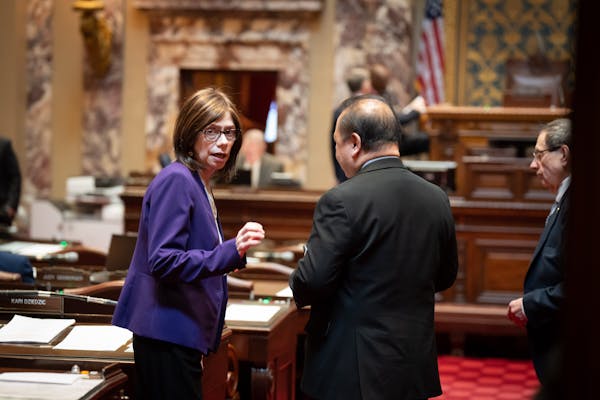Minnesota's community solar garden program — a critical but sometimes controversial part of the state's solar power rollout — will be overhauled under legislation the governor signed Wednesday.
Community solar gardens are relatively small, but together they have a big impact.
The program, created by the Legislature in 2013, accounts for more than 60% of the solar energy produced in Minnesota.
However, the installations — aimed at customers who do not want to put up their own solar panels — are relatively expensive and provide considerably more power to businesses than residents. Plus, Xcel Energy ratepayers basically help fund it.
In a compromise between the House and the Senate, the new solar garden program will cater more to residents, particularly lower-income households. But some of the costs will continue to be passed down to Xcel's ratepayers.
The new program contains "important improvements," particularly its emphasis on energy equity and lower-income consumers, said Isabel Ricker, director for clean electricity at Fresh Energy, a St. Paul advocacy group.
"Our remaining concern is around the overall cost of the program on an ongoing basis," she said.
Under the current community solar program, Xcel — the state's largest electric utility — must buy energy from solar gardens built by independent developers.
Developers earn a profit on the community solar gardens; Xcel doesn't. Xcel also administers the current program, which will remain in effect until year's end. Community solar gardens built under the current program will continue operating under its rules.
The Minnesota Department of Commerce will administer the new program, although Xcel will still assess grid connections for projects chosen by the state agency.
While both the House and Senate are controlled by the DFL, two very different solar garden bills surfaced during the legislative session.
The House bill called for expanding the current program, which allows "subscribers" to community solar gardens to reduce their power bills — through bill credits — by selling electricity to Xcel.
The Senate bill would have jettisoned the subscription model, partly due to its escalating costs. The Senate instead called for a program that would allow developers to build bigger solar gardens that would produce up to 10 megawatts of energy instead of the 1 megawatt allowed currently.
Under the Senate proposal, Xcel would have bid out the new 10-megawatt solar farms — as it already does for larger, "utility" scale solar arrays, which are often 100 megawatts or more. The Senate also would have allowed Xcel to own up to 30% of these new solar arrays.
In conference committee, DFL legislators took the Senate and House proposals, tweaked them, and then essentially combined them in the omnibus energy bill. The legislation is silent on whether Xcel can own any of the new 10-megawatt arrays.
The new 10-megawatt, non-subscription solar farms would add 700 to 800 megawatts of new solar by 2030, said Logan O'Grady, head of the state's solar industry trade group, Minnesota Solar Energy Industries Association.
The new subscription program would add up to 680 megawatts between 2024 and 2031, though it calls for annual caps. (The current solar garden program has more than 850 megawatts up and running). The new subscription program would also raise the maximum solar garden size from 1 to 5 megawatts.
"By and large, this bill works very well for the solar industry," O'Grady said.
While solar garden subscribers save money, Xcel's ratepayers essentially fund some of those savings.
That's because power produced by the larger solar projects built by Xcel and other utilities — which benefit from economies of scale — is cheaper on a per-kilowatt-hour basis than electricity generated by the solar gardens
The annual wholesale cost of solar garden electricity is about $100 million above market prices for energy, Xcel said in a February filing with the Minnesota Public Utilities Commission (PUC).
The company says its average residential customer pays about $4 per month for the community solar program.
The new subscription solar garden program will have different pricing than the current one, but it's not clear if it will cost more or less.
The PUC, in a letter to the House-Senate energy conference committee, said that expanding the current solar garden program — as proposed by the House — "will likely exacerbate the rate impacts" already occurring.
The new legislation did not seem to ease its concerns.
"I am worried as a commissioner about the rate implications of the community solar program," PUC Commissioner Joe Sullivan said in an interview this week.
Xcel said in a statement that it is analyzing the cost structure of the new community solar garden program. The company also said the legislation doesn't address the "congestion" on its grid caused by the construction of more than 460 community solar gardens.
As of October, 86% of community solar garden subscribers were residential customers. However, more than 80% of the power generated by those same gardens went to businesses and other non-residential customers.
The new solar garden program should remedy that imbalance, with requirements for more residential subscribers, said Timothy DenHerder-Thomas, general manager of Minneapolis-based Cooperative Energy Futures, which focuses on clean energy for lower-income residents.
Low- to moderate-income residents — those with less than 150% of the area median household income — must receive at least 30% of each new solar garden's power generation capacity.
And at least 55 % of the new solar gardens' subscribers must be a combination of lower-income residents, affordable housing providers and "public interest" groups — meaning nonprofits, churches and tribes.
"It is definitely an improvement from where we were," DenHerder-Thomas said. "I think this is a major step forward for equity and community benefits in the community solar garden program."
New York City turns to AI-powered scanners in push to keep guns out of the subway system
North Carolina regulators says nonprofit run by lieutenant governor's wife owes the state $132K


